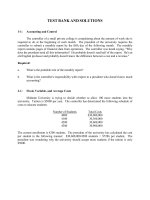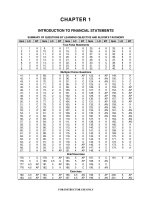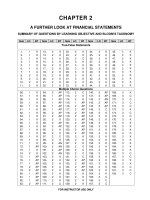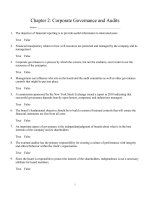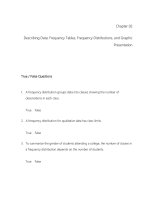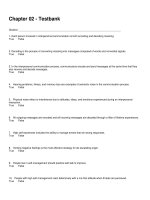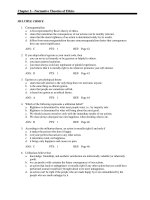Business statistics for contemporary decision making 8th edition black test bank
Bạn đang xem bản rút gọn của tài liệu. Xem và tải ngay bản đầy đủ của tài liệu tại đây (908.33 KB, 46 trang )
File: ch02, Chapter 2: Charts and Graphs
True/False
1. A summary of data in which raw data are grouped into different intervals and the number of
items in each group is listed is called a frequency distribution.
Ans: True
Response: See section 2.1 Frequency Distributions
Difficulty: Easy
Learning Objective: 2.1: Construct a frequency distribution from a set of data.
2. If the individual class frequency is divided by the total frequency, the result is the median
frequency.
Ans: False
Response: See section 2.1 Frequency Distributions
Difficulty: Medium
Learning Objective: 2.1: Construct a frequency distribution from a set of data.
3. A cumulative frequency distribution provides a running total of the frequencies in the classes.
Ans: True
Response: See section 2.1 Frequency Distributions
Difficulty: Medium
Learning Objective: 2.1: Construct a frequency distribution from a set of data.
4. The difference between the highest number and the lowest number in a set of data is called
the differential frequency.
Ans: False
Response: See section 2.1 Frequency Distributions
Difficulty: Medium
Learning Objective: 2.1: Construct a frequency distribution from a set of data.
5. For any given data set, a frequency distribution with a larger number of classes will always be
better than the one with a smaller number of classes.
Ans: False
Response: See section 2.1 Frequency Distributions
Difficulty: Medium
Learning Objective: 2.1: Construct a frequency distribution from a set of data.
6. One rule that must always be followed in constructing frequency distributions is that the
adjacent classes must overlap.
Ans: False
Response: See section 2.1 Frequency Distributions
Difficulty: Medium
Learning Objective: 2.1: Construct a frequency distribution from a set of data.
7. An instructor made a frequency table of the scores his students got on a test
Score
30-under 40
40-under 50
50-under 60
60-under 70
70-under 80
80-under 90
90-under 100
The midpoint of the last class interval is _________.
a) 90
b) 5
c) 95
d) 100
e) 50
Frequency
1
4
5
10
20
10
5
Ans: c
Response: See section 2.1 Frequency Distributions
Difficulty: Easy
Learning Objective: 2.1: Construct a frequency distribution from a set of data.
8. An instructor made a frequency table of the scores his students got on a test
Score
30-under 40
40-under 50
50-under 60
60-under 70
70-under 80
80-under 90
90-under 100
Frequency
1
4
5
10
20
10
5
Approximately what percent of students got more than 70?
a) 36
b) 20
c) 50
d) 10
e) 64
Ans: e
Response: See section 2.1 Frequency Distributions
Difficulty: Easy
Learning Objective: 2.1: Construct a frequency distribution from a set of data.
9. A cumulative frequency polygon is also called an ogive.
Ans: True
Response: See section 2.2 Quantitative Data Graphs
Difficulty: Medium
Learning Objective: 2.2: Construct different types of quantitative data graphs, including
histograms, frequency polygons, ogives, dot plots, and stem-and-leaf plots, in order to interpret
the data being graphed.
10. A histogram can be described as a type of vertical bar chart.
Ans: True
Response: See section 2.2 Quantitative Data Graphs
Difficulty: Medium
Learning Objective: 2.2: Construct different types of quantitative data graphs, including
histograms, frequency polygons, ogives, dot plots, and stem-and-leaf plots, in order to interpret
the data being graphed.
11. One advantage of a stem and leaf plot over a frequency distribution is that the values of the
original data are retained.
Ans: True
Response: See section 2.2 Quantitative Data Graphs
Difficulty: Medium
Learning Objective: 2.2: Construct different types of quantitative data graphs, including
histograms, frequency polygons, ogives, dot plots, and stem-and-leaf plots, in order to interpret
the data being graphed.
12. For a company in gardening supplies business, the best graphical way to show the percentage
of a total budget that is spent on each of a number of different expense categories is the stem and
leaf plot.
Ans: False
Response: See section 2.2 Quantitative Data Graphs
Difficulty: Hard
Learning Objective: 2.2: Construct different types of quantitative data graphs, including
histograms, frequency polygons, ogives, dot plots, and stem-and-leaf plots, in order to interpret
the data being graphed.
13. In a histogram, the tallest bar represents the class with the highest cumulative frequency.
Ans: False
Response: See section 2.2 Quantitative Data Graphs
Difficulty: Medium
Learning Objective: 2.2: Construct different types of quantitative data graphs, including
histograms, frequency polygons, ogives, dot plots, and stem-and-leaf plots, in order to interpret
the data being graphed.
14. Dot Plots are mainly used to display a large data set.
Ans: False
Response: See section 2.2 Quantitative Data Graphs
Difficulty: Medium
Learning Objective: 2.2: Construct different types of quantitative data graphs, including
histograms, frequency polygons, ogives, dot plots, and stem-and-leaf plots, in order to interpret
the data being graphed.
15. A graphical representation of a frequency distribution is called a pie chart.
Ans: False
Response: See section 2.3 Qualitative Data Graphs
Difficulty: Easy
Learning Objective: 2.3: Construct different types of qualitative data graphs, including pie charts,
bar graphs, and Pareto charts, in order to interpret the data being graphed.
16. In contrast to quantitative data graphs that are plotted along a numerical scale, qualitative
graphs are plotted using non-numerical categories.
Ans: True
Response: See section 2.3 Qualitative Data Graphs
Difficulty: Easy
Learning Objective: 2.3: Construct different types of qualitative data graphs, including pie charts,
bar graphs, and Pareto charts, in order to interpret the data being graphed.
17. A Pareto chart and a pie chart are both types of qualitative graphs.
Ans: True
Response: See section 2.3 Qualitative Data Graphs
Difficulty: Easy
Learning Objective: 2.3: Construct different types of qualitative data graphs, including pie charts,
bar graphs, and Pareto charts, in order to interpret the data being graphed.
18. A scatter plot shows how the numbers in a data set are scattered around their average.
Ans: False
Response: See section 2.4 Charts and Graphs for Two Variables.
Difficulty: Medium
Learning objective: 2.4: Recognize basic trends in two-variable scatter plots of numerical data.
19. A scatter plot is a two-dimensional graph plot of data containing pairs of observations on two
numerical variables.
Ans: True
Response: See section 2.4 Charts and Graphs for Two Variables
Difficulty: Medium
Learning objective: 2.4: Recognize basic trends in two-variable scatter plots of numerical data.
20. A scatter plot is useful for examining the relationship between two numerical variables.
Ans: True
Response: See section 2.4 Charts and Graphs for Two Variables
Difficulty: Medium
Learning objective: 2.4: Recognize basic trends in two-variable scatter plots of numerical data.
Multiple Choice
21. Consider the following frequency distribution:
Class Interval
Frequency
10-under 20
15
20-under 30
25
30-under 40
10
What is the midpoint of the first class?
a) 10
b) 20
c) 15
d) 30
e) 40
Ans: c
Response: See section 2.1 Frequency Distributions
Difficulty: Easy
Learning Objective: 2.1: Construct a frequency distribution from a set of data.
22. Consider the following frequency distribution:
Class Interval
Frequency
10-under 20
15
20-under 30
25
30-under 40
10
What is the relative frequency of the first class?
a) 0.15
b) 0.30
c) 0.10
d) 0.20
e) 0.40
Ans: b
Response: See section 2.1 Frequency Distributions
Difficulty: Medium
Learning Objective: 2.1: Construct a frequency distribution from a set of data.
23. Consider the following frequency distribution:
Class Interval
Frequency
10-under 20
15
20-under 30
25
30-under 40
10
What is the cumulative frequency of the second class interval?
a) 25
b) 40
c) 15
d) 50
Ans: b
Response: See section 2.1 Frequency Distributions
Difficulty: Medium
Learning Objective: 2.1: Construct a frequency distribution from a set of data.
24. The number of phone calls arriving at a switchboard each hour has been recorded, and the
following frequency distribution has been developed.
Class Interval
Frequency
20-under 40
30
40-under 60
45
60-under 80
80
80-under 100
45
What is the midpoint of the last class?
a) 80
b) 100
c) 95
d) 90
e) 85
Ans: d
Response: See section 2.1 Frequency Distributions
Difficulty: Easy
Learning Objective: 2.1: Construct a frequency distribution from a set of data.
25. The number of phone calls arriving at a switchboard each hour has been recorded, and the
following frequency distribution has been developed.
Class Interval
Frequency
20-under 40
30
40-under 60
45
60-under 80
80
80-under 100
45
What is the relative frequency of the second class?
a) 0.455
b) 0.900
c) 0.225
d) 0.750
e) 0.725
Ans: c
Response: See section 2.1 Frequency Distributions
Difficulty: Medium
Learning Objective: 2.1: Construct a frequency distribution from a set of data.
26. The number of phone calls arriving at a switchboard each hour has been recorded, and the
following frequency distribution has been developed.
Class Interval
Frequency
20-under 40
30
40-under 60
45
60-under 80
80
80-under 100
45
What is the cumulative frequency of the third class?
a) 80
b) 0.40
c) 155
d) 75
e) 105
Ans: c
Response: See section 2.1 Frequency Distributions
Difficulty: Medium
Learning Objective: 2.1: Construct a frequency distribution from a set of data.
27 A person has decided to construct a frequency distribution for a set of data containing 60
numbers. The lowest number is 23 and the highest number is 68. If 5 classes are used, the class
width should be approximately _______.
a) 4
b) 12
c) 8
d) 5
e) 9
Ans: e
Response: See section 2.1 Frequency Distributions
Difficulty: Easy
Learning Objective: 2.1: Construct a frequency distribution from a set of data.
28. A person has decided to construct a frequency distribution for a set of data containing 60
numbers. The lowest number is 23 and the highest number is 68. If 7 classes are used, the class
width should be approximately _______.
a) 5
b) 7
c) 9
d) 11
e) 12
Ans: b
Response: See section 2.1 Frequency Distributions
Difficulty: Medium
Learning Objective: 2.1: Construct a frequency distribution from a set of data.
29. A frequency distribution was developed. The lower endpoint of the first class is 9.30, and
the midpoint is 9.35. What is the upper endpoint of this class?
a) 9.50
b) 9.60
c) 9.70
d) 9.40
e) 9.80
Ans: d
Response: See section 2.1 Frequency Distributions
Difficulty: Medium
Learning Objective: 2.1: Construct a frequency distribution from a set of data.
30. The cumulative frequency for a class is 27. The cumulative frequency for the next (nonempty) class will be _______.
a) less than 27
b) equal to 27
c) next class frequency minus 27
d) 27 minus the next class frequency
e) 27 plus the next class frequency
Ans: e
Response: See section 2.1 Frequency Distributions
Difficulty: Hard
Learning Objective: 2.1: Construct a frequency distribution from a set of data.
31. The following class intervals for a frequency distribution were developed to provide
information regarding the starting salaries for students graduating from a particular school:
Salary
Number of Graduates
($1,000s)
28-under 31
31-under 35
34-under 37
39-under 40
Before data was collected, someone questioned the validity of this arrangement. Which of the
following represents a problem with this set of intervals?
a) There are too many intervals.
b) The class widths are too small.
c) Some numbers between 28,000 and 40,000 would fall into two different intervals.
d) The first and the second interval overlap.
e) There are too few intervals.
Ans: c
Response: See section 2.1 Frequency Distributions
Difficulty: Medium
Learning Objective: 2.1: Construct a frequency distribution from a set of data.
32. The following class intervals for a frequency distribution were developed to provide
information regarding the starting salaries for students graduating from a particular school:
Salary
Number of Graduates
($1,000s)
28-under 31
31-under 35
34-under 37
39-under 40
Before data was collected, someone questioned the validity of this arrangement. Which of the
following represents a problem with this set of intervals?
a) There are too many intervals.
b) The class widths are too small.
c) Some numbers between 28,000 and 40,000 would not fall into any of these intervals.
d) The first and the second interval overlap.
e) There are too few intervals.
Ans: c
Response: See section 2.1 Frequency Distributions
Difficulty: Hard
Learning Objective: 2.1: Construct a frequency distribution from a set of data.
33. The following class intervals for a frequency distribution were developed to provide
information regarding the starting salaries for students graduating from a particular school:
Salary
Number of Graduates
($1,000s)
28-under 31
31-under 35
34-under 37
39-under 340
Before data was collected, someone questioned the validity of this arrangement. Which of the
following represents a problem with this set of intervals?
a) There are too many intervals.
b) The class widths are too small.
c) The class widths are too large.
d) The second and the third interval overlap.
e) There are too few intervals.
Ans: d
Response: See section 2.1 Frequency Distributions
Difficulty: Medium
Learning Objective: 2.1: Construct a frequency distribution from a set of data.
34. Abel Alonzo, Director of Human Resources, is exploring employee absenteeism at the
Harrison Haulers Plant during the last operating year. A review of all personnel records
indicated that absences ranged from zero to twenty-nine days per employee. The following class
intervals were proposed for a frequency distribution of absences.
Absences
Number of Employees
(Days)
0-under 5
5-under 10
10-under 15
20-under 25
25-under 30
Which of the following represents a problem with this set of intervals?
a) There are too few intervals.
b) Some numbers between 0 and 29, inclusively, would not fall into any interval.
c) The first and second interval overlaps.
d) There are too many intervals.
e) The second and the third interval overlap.
Ans: b
Response: See section 2.1 Frequency Distributions
Difficulty: Medium
Learning Objective: 2.1: Construct a frequency distribution from a set of data.
35. Abel Alonzo, Director of Human Resources, is exploring employee absenteeism at the
Harrison Haulers Plant during the last operating year. A review of all personnel records
indicated that absences ranged from zero to twenty-nine days per employee. The following class
intervals were proposed for a frequency distribution of absences.
Absences
Number of Employees
(Days)
0-under 10
10-under 20
20-under 30
Which of the following might represent a problem with this set of intervals?
a) There are too few intervals.
b) Some numbers between 0 and 29 would not fall into any interval.
c) The first and second interval overlaps.
d) There are too many intervals.
e) The second and the third interval overlap.
Ans: a
Response: See section 2.1 Frequency Distributions
Difficulty: Medium
Learning Objective: 2.1: Construct a frequency distribution from a set of data.
36. Consider the relative frequency distribution given below:
Class Interval
Relative Frequency
20-under 40
0.2
40-under 60
0.3
60-under 80
0.4
80-under 100
0.1
There were 60 numbers in the data set. How many numbers were in the interval 20-under 40?
a) 12
b) 20
c) 40
d) 10
e) 15
Ans: a
Response: See section 2.1 Frequency Distributions
Difficulty: Easy
Learning Objective: 2.1: Construct a frequency distribution from a set of data.
37. Consider the relative frequency distribution given below:
Class Interval
Relative Frequency
20-under 40
0.2
40-under 60
0.3
60-under 80
0.4
80-under 100
0.1
There were 60 numbers in the data set. How many numbers were in the interval 40-under 60?
a) 30
b) 50
c) 18
d) 12
e) 15
Ans: c
Response: See section 2.1 Frequency Distributions
Difficulty: Easy
Learning Objective: 2.1: Construct a frequency distribution from a set of data.
38. Consider the relative frequency distribution given below:
Class Interval
Relative Frequency
20-under 40
0.2
40-under 60
0.3
60-under 80
0.4
80-under 100
0.1
There were 60 numbers in the data set. How many of the number were less than 80?
a) 90
b) 80
c) 0.9
d) 54
e) 100
Ans: d
Response: See section 2.1 Frequency Distributions
Difficulty: Medium
Learning Objective: 2.1: Construct a frequency distribution from a set of data.
39. Consider the following frequency distribution:
Class Interval
Frequency
100-under 200
25
200-under 300
45
300-under 400
30
What is the midpoint of the first class?
a) 100
b) 150
c) 25
d) 250
e) 200
Ans: b
Response: See section 2.1 Frequency Distributions
Difficulty: Easy
Learning Objective: 2.1: Construct a frequency distribution from a set of data.
40. Consider the following frequency distribution:
Class Interval
Frequency
100-under 200
25
200-under 300
45
300-under 400
30
What is the relative frequency of the second class interval?
a) 0.45
b) 0.70
c) 0.30
d) 0.33
e) 0.50
Ans: a
Response: See section 2.1 Frequency Distributions
Difficulty: Medium
Learning Objective: 2.1: Construct a frequency distribution from a set of data.
41. Consider the following frequency distribution:
Class Interval
Frequency
100-under 200
25
200-under 300
45
300-under 400
30
What is the cumulative frequency of the second class interval?
a) 25
b) 45
c) 70
d) 100
e) 250
Ans: c
Response: See section 2.1 Frequency Distributions
Difficulty: Medium
Learning Objective: 2.1: Construct a frequency distribution from a set of data.
42. Consider the following frequency distribution:
Class Interval
Frequency
100-under 200
25
200-under 300
45
300-under 400
30
What is the midpoint of the last class interval?
a) 15
b) 350
c) 300
d) 200
e) 400
Ans: b
Response: See section 2.1 Frequency Distributions
Difficulty: Easy
Learning Objective: 2.1: Construct a frequency distribution from a set of data.
43. Pinky Bauer, Chief Financial Officer of Harrison Haulers, Inc., suspects irregularities in the
payroll system and orders an inspection of "each and every payroll voucher issued since January
1, 2000." Each payroll voucher was inspected and the following frequency distribution was
compiled.
Errors per Voucher
Number of Vouchers
0-under 2
500
2-under 4
400
4-under 6
300
6-under 8
200
8-under 10
100
The relative frequency of the first class interval is _________.
a) 0.50
b) 0.33
c) 0.40
d) 0.27
e) 0.67
Ans: b
Response: See section 2.1 Frequency Distributions
Difficulty: Medium
Learning Objective: 2.1: Construct a frequency distribution from a set of data.
44. Pinky Bauer, Chief Financial Officer of Harrison Haulers, Inc., suspects irregularities
in the payroll system and orders an inspection of "each and every payroll voucher issued since
January 1, 2000." Each payroll voucher was inspected and the following frequency distribution
was compiled.
Errors per Voucher
Number of Vouchers
0-under 2
500
2-under 4
400
4-under 6
300
6-under 8
200
8-under 10
100
The cumulative frequency of the second class interval is _________.
a) 1,500
b) 500
c) 900
d) 1,000
e) 1,200
Ans: c
Response: See section 2.1 Frequency Distributions
Difficulty: Medium
Learning Objective: 2.1: Construct a frequency distribution from a set of data.
45. Pinky Bauer, Chief Financial Officer of Harrison Haulers, Inc., suspects irregularities in the
payroll system and orders an inspection of "each and every payroll voucher issued since January
1, 2000." Each payroll voucher was inspected and the following frequency distribution was
compiled.
Errors per Voucher
Number of Vouchers
0-under 2
500
2-under 4
400
4-under 6
300
6-under 8
200
8-under 10
100
The midpoint of the first class interval is _________.
a) 500
b) 2
c) 1.5
d) 1
e) 250
Ans: d
Response: See section 2.1 Frequency Distributions
Difficulty: Easy
Learning Objective: 2.1: Construct a frequency distribution from a set of data.
46. Consider the following stem and leaf plot:
Stem
Leaf
1
0, 2, 5, 7
2
2, 3, 4, 4
3
0, 4, 6, 6, 9
4
5, 8, 8, 9
5
2, 7, 8
Suppose that a frequency distribution was developed from this, and there were 5 classes (10under 20, 20-under 30, etc.). What would the frequency be for class 30-under 40?
a) 3
b) 4
c) 6
d) 7
e) 5
Ans: e
Response: See section 2.2 Quantitative Data Graphs
Difficulty: Medium
Learning Objective: 2.2: Construct different types of quantitative data graphs, including
histograms, frequency polygons, ogives, dot plots, and stem-and-leaf plots, in order to interpret
the data being graphed.
47 Consider the following stem and leaf plot:
Stem
Leaf
1
0, 2, 5, 7
2
2, 3, 4, 8
3
0, 4, 6, 6, 9
4
5, 8, 8, 9
5
2, 7, 8
Suppose that a frequency distribution was developed from this, and there were 5 classes (10under 20, 20-under 30, etc.). What would be the relative frequency of the class 20-under 30?
a) 0.4
b) 0.25
c) 0.20
d) 4
e) 0.50
Ans: c
Response: See section 2.2 Quantitative Data Graphs
Difficulty: Medium
Learning Objective: 2.2: Construct different types of quantitative data graphs, including
histograms, frequency polygons, ogives, dot plots, and stem-and-leaf plots, in order to interpret
the data being graphed.
48. Consider the following stem and leaf plot:
Stem
Leaf
1
0, 2, 5, 7
2
2, 3, 4, 8
3
0, 4, 6, 6, 9
4
5, 8, 8, 9
5
2, 7, 8
Suppose that a frequency distribution was developed from this, and there were 5 classes (10under 20, 20-under 30, etc.). What was the highest number in the data set?
a) 50
b) 58
c) 59
d) 78
e) 98
Ans: b
Response: See section 2.2 Quantitative Data Graphs
Difficulty: Medium
Learning Objective: 2.2: Construct different types of quantitative data graphs, including
histograms, frequency polygons, ogives, dot plots, and stem-and-leaf plots, in order to interpret
the data being graphed.
49. Consider the following stem and leaf plot:
Stem
Leaf
1
0, 2, 5, 7
2
2, 3, 4, 8
3
0, 4, 6, 6, 9
4
5, 8, 8, 9
5
2, 7, 8
Suppose that a frequency distribution was developed from this, and there were 5 classes (10under 20, 20-under 30, etc.). What was the lowest number in the data set?
a) 0
b) 10
c) 7
d) 2
e) 1
Ans: b
Response: See section 2.2 Quantitative Data Graphs
Difficulty: Medium
Learning Objective: 2.2: Construct different types of quantitative data graphs, including
histograms, frequency polygons, ogives, dot plots, and stem-and-leaf plots, in order to interpret
the data being graphed.
50. Consider the following stem and leaf plot:
Stem
Leaf
1
0, 2, 5, 7
2
2, 3, 4, 8
3
0, 4, 6, 6, 9
4
5, 8, 8, 9
5
2, 7, 8
Suppose that a frequency distribution was developed from this, and there were 5 classes (10under 20, 20-under 30, etc.). What is the cumulative frequency for the 30-under 40 class
interval?
a) 5
b) 9
c) 13
d) 14
e) 18
Ans: c
Response: See section 2.2 Quantitative Data Graphs
Difficulty: Medium
Learning Objective: 2.2: Construct different types of quantitative data graphs, including
histograms, frequency polygons, ogives, dot plots, and stem-and-leaf plots, in order to interpret
the data being graphed.
51. The following represent the ages of students in a class:
19, 23, 21, 19, 19, 20, 22, 31, 21, 20
If a stem and leaf plot were to be developed from this, how many stems would there be?
a) 2
b) 3
c) 4
d) 5
e) 10
Ans: b
Response: See section 2.2 Quantitative Data Graphs
Difficulty: Medium
Learning Objective: 2.2: Construct different types of quantitative data graphs, including
histograms, frequency polygons, ogives, dot plots, and stem-and-leaf plots, in order to interpret
the data being graphed.
52. Each day, the office staff at Oasis Quick Shop prepares a frequency distribution and an ogive
of sales transactions by dollar value of the transactions. Saturday's cumulative frequency ogive
follows.
The total number of sales transactions on Saturday was _____________.
a) 200
b) 500
c) 300
d) 100
e) 400
Ans: b
Response: See section 2.2 Quantitative Data Graphs
Difficulty: Medium
Learning Objective: 2.2: Construct different types of quantitative data graphs, including
histograms, frequency polygons, ogives, dot plots, and stem-and-leaf plots, in order to interpret
the data being graphed.
53. Each day, the office staff at Oasis Quick Shop prepares a frequency distribution and an ogive
of sales transactions by dollar value of the transactions. Saturday's cumulative frequency ogive
follows.
The percentage of sales transactions on Saturday that were under $100 each was _____________.
a) 100
b) 10
c) 80
d) 20
e) 15
Ans: d
Response: See section 2.2 Quantitative Data Graphs
Difficulty: Medium
Learning Objective: 2.2: Construct different types of quantitative data graphs, including
histograms, frequency polygons, ogives, dot plots, and stem-and-leaf plots, in order to interpret
the data being graphed.
54. Each day, the office staff at Oasis Quick Shop prepares a frequency distribution and an ogive
of sales transactions by dollar value of the transactions. Saturday's cumulative frequency ogive
follows.
The percentage of sales transactions on Saturday that were at least $100 each was
_____________.
a) 100
b) 10
c) 80
d) 20
e) 15
Ans: c
Response: See section 2.2 Quantitative Data Graphs
Difficulty: Medium
Learning Objective: 2.2: Construct different types of quantitative data graphs, including
histograms, frequency polygons, ogives, dot plots, and stem-and-leaf plots, in order to interpret
the data being graphed.
55. Each day, the office staff at Oasis Quick Shop prepares a frequency distribution and an ogive
of sales transactions by dollar value of the transactions. Saturday's cumulative frequency ogive
follows.
The percentage of sales transactions on Saturday that were between $100 and $150 was
_____________.
a) 20%
b) 40%
c) 60%
d) 80%
e) 10%
Ans: c
Response: See section 2.2 Quantitative Data Graphs
Difficulty: Hard
Learning Objective: 2.2: Construct different types of quantitative data graphs, including
histograms, frequency polygons, ogives, dot plots, and stem-and-leaf plots, in order to interpret
the data being graphed.
56. Each day, the manager at Jamie’s Auto Care Shop prepares a frequency distribution and a
histogram of sales transactions by dollar value of the transactions. Friday's histogram follows.
On Friday, the approximate number of sales transactions in the 75-under 100 category was
_____________.
a) 50
b) 100
c) 150
d) 200
e) 60
Ans: e
Response: See section 2.2 Quantitative Data Graphs
Difficulty: Medium
Learning Objective: 2.2: Construct different types of quantitative data graphs, including
histograms, frequency polygons, ogives, dot plots, and stem-and-leaf plots, in order to interpret
the data being graphed.
57. Each day, the manager at Jamie’s Auto Care prepares a frequency distribution and a
histogram of sales transactions by dollar value of the transactions. Friday's histogram follows.
On Friday, the approximate number of sales transactions between $150 and $175 was
_____________.
a) 75
b) 200
c) 300
d) 400
e) 500
Ans: a
Response: See section 2.2 Quantitative Data Graphs
Difficulty: Medium
Learning Objective: 2.2: Construct different types of quantitative data graphs, including
histograms, frequency polygons, ogives, dot plots, and stem-and-leaf plots, in
order to interpret the data being graphed.
58. The staff of Mr. Wayne Wertz, VP of Operations at Portland Peoples Bank, prepared a
cumulative frequency ogive of waiting time for walk-in customers.
The total number of walk-in customers included in the study was _________.
a) 100
b) 250
c) 300
d) 450
e) 500
Ans: d
Response: See section 2.2 Quantitative Data Graphs
Difficulty: Medium
Learning Objective: 2.2: Construct different types of quantitative data graphs, including
histograms, frequency polygons, ogives, dot plots, and stem-and-leaf plots, in order to interpret
the data being graphed.
59. The staff of Mr. Wayne Wertz, VP of Operations at Portland Peoples Bank, prepared a
cumulative frequency ogive of waiting time for walk-in customers.
The percentage of walk-in customers waiting one minute or less was _________.
a) 22%
